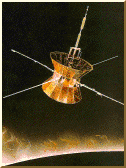HELIOS was a joint German-American project to study interplanetary space and processes in the vicinity of the Sun using two nearly identical spacecraft. In addition to being a milestone of international cooperation in space, this project generated a vast wealth of scientific knowledge on solar-terrestrial relations and the associated data remain an important resource for ongoing studies.
HELIOS 1 was launched on December 10, 1974, and HELIOS 2 on January 15, 1976. Both were placed in elliptical orbits about the Sun with their perihelions well within the orbit of Mercury, aphelions at the orbit of Earth, and orbital periods of about 190 days.
Research instruments aboard each probe included:
- particle analyzers which observed the velocities and numbers of electrons and positive ions in the solar wind (E1)
- two magnetometers which measured the magnetic field (E2 and E3)
- a search coil magnetometer which measured higher frequency magnetic fields (E4)
- electric field antennae and detectors which measured plasma and radio waves (E5)
- a set of particle telescopes which measured the directions and energies of impinging cosmic radiation (E6, E7, E8)
- on HELIOS 2, a device for recording gamma-ray bursts
- a solar X-ray detector (E7)
- three directional photometers for measuring zodiacal light (E9)
- two dust particle detectors (E10)
Researchers from the University of Iowa, the University of Minnesota, and Goddard Space Flight Center were responsible for different aspects of Experiment 5, the plasma and radio wave experiments. The University of Iowa plasma wave experiment (E5A) utilized the 32 meter tip-to-tip dipole antenna to detect the electric component of plasma waves.
HELIOS E5A Plasma Wave Experiment
- Science Summary
- Investigators
- Instruments
- Images
- Observations
- Publications
- Access to Data
More HELIOS Information
- Helios Spacecraft from Max Planck Institute for Solar System Research
- Coordinated Heliospheric Observations (COHOWeb at NSSDC)
- Heliocentric Trajectories for Selected Spacecraft, Planets, Comets
 HELIOS E5A
HELIOS E5A